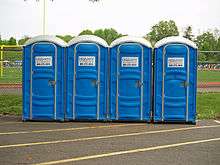Chemical toilet


.jpg)
A chemical toilet collects human excreta in a holding tank and uses chemicals to minimize odors. These toilets are usually, but not always, self-contained and movable. A chemical toilet is structured around a relatively small tank, which needs to be emptied frequently. It is not connected to a hole in the ground (like a pit latrine), nor to a septic tank, nor is it plumbed into a municipal system leading to a sewage treatment plant.[1] When the tank is emptied, the contents are usually pumped into a sanitary sewer or directly to a treatment plant.
The portable toilets used on construction sites and at large gatherings such as music festivals are well-known types of chemical toilet. As they are usually used for short periods and because of their high prices, they are mostly rented rather than bought, often including servicing and cleaning.[2]
Aircraft lavatories and passenger train toilets were in the past often designed as chemical toilets but are nowadays more likely to be vacuum toilets.
A simpler type of chemical toilet may be used in travel trailers (caravans) and on small boats.
Many chemical toilets use a blue dye in the bowl water. In the past, disinfection was generally carried out by mixing formaldehyde, bleach, or similar chemicals with the toilet water when flushed. Modern formulations are nitrate-based and work biologically.
Names
Chemical toilets are a type of portable toilet and is also known by various tradenames, such as Port-a-John (American English), Portaloo (British English), or honey bucket. The last two are the names of companies[3] and "Portaloo" is a British and European Community registered trade mark.[4]
Designs
Chemical toilets are often used as a temporary solution, for example on construction sites or large gatherings, because of their durability and convenience. Most chemical toilets have open-front U-shaped toilet seats with a cover. They are often constructed out of lightweight molded plastic.
Chemical toilets are large enough for a single occupant, usually about 110 cm (43 in) square by 210 cm (83 in) high. While the units are typically free-standing structures, their stability is augmented by the weight of the waste tank, which usually contains an empty liquid disinfectant dispenser and deodorizer. Some include both a seated toilet and a urinal. Most include lockable doors, ventilation near the top, and a vent pipe for the holding tank. When wind is blowing over the vent pipe it creates a low pressure area sucking the odor out. Leaving the toilet lid open will reverse the flow of the venting of the tank.
Typical specifications:
- Total Weight: 90 kg (200 lb) - 110 kg (240 lb)
- Total Width : 1,166 mm (45.9 in)
- Total Depth : 1,215 mm (47.8 in)
- Total Height : 2,316 mm (91.2 in)
- Door Height : 1,975 mm (77.8 in)
- Door Width : 639 mm (25.2 in)
Chemicals
Portable chemical toilets often use a smell-reducing chemical (deodorizer) in the holding tank. This chemical is typically blue so that when it interacts with enough urine and feces, it turns green. This green color is an indication that the chemicals are no longer effective in preventing odors.
A formaldehyde (embalming fluid) based chemical is often used to neutralize odors.
Since the chemical solution can splash back onto the buttocks of the user when his excrement plops in, and because formaldehyde is very irritating to the eyes, ears, skin, nose, and throat, it is being replaced by other proprietary blends such as glutaraldehyde[5] and quaternary ammonium compounds,[6] with non-staining dyes and nature-identical perfume oils. Additionally, enzyme hybrids are sometimes used.
A much older form of portable toilet chemical is lye. Lye was used during the old "wooden outhouse days" to prevent odors. After a person is done using the portable toilet they would sprinkle a bit of lye into the holding tank. Lye can be dangerously corrosive to skin, and is rarely used today.
Alternatives
A notable exception to the formaldehyde based formula is California, which has banned the use of this chemical in portable toilets, RV's and the like because it may interfere with their sewage plant operations if large volumes of waste from portable toilets are dumped there. A more environmentally friendly enzyme is used to break down the waste while releasing a fragrance, sold by Greenway by PolyPortables. This enzyme does not prevent the bacteria from breaking down waste but actually helps break down waste itself.
Locations

They are frequently seen at outdoor work sites, particularly construction sites, farms, ranches, camp sites and large banks of dozens of portable toilets allow for ready sanitation at large gatherings such as outdoor music festivals. Several portable toilets arranged in these large banks are referred to as a 'sitting' of portable toilets.
Variations
Newer models include toilet paper and, occasionally, antibacterial hand sanitizer dispensers. It has become common for portable toilets to be paired with an internal hand washing station. These sink stations provide a foot pump to dispense water to wash one's hands after using the toilet. Soap and towels may be provided.
Another common pairing are portable toilets on trailers known commonly as a "toilet trailer". These trailers are typically found in 1–2 toilet configurations with a hand wash ability using either a hand washing station or a plastic barrel full of water. These trailers are often seen on agricultural fields or at road construction sites. These restrooms are ideal for situations where the workers (users) are very mobile. However, this configuration has proven problematic; most modern portable toilet waste tank designs have proven inadequate to deal with the common problem of splash-outs from the waste holding tank while being towed down bumpy roads. Also, when being towed, the high winds blow in from the vents, creating a hurricane effect inside and ejecting any toilet paper rolls from the portable toilet if not secured.
'Luxury' portable toilets also exist. They are typically mounted on large "office-like" trailers or made from converted shipping containers. They contain every amenity that a public bathroom would have such as running water, flushing toilet, stalls, urinals, mirrors, lighting, and even air conditioning and hot water in some cases. However, these luxuries come at a price as these trailers typically cost multiple times more than a typical portable toilet to buy or rent. They are commonly found at weddings, high end events/charities, and movie shoots.
The chemical toilets used on film shoots are known as honeywagons.

Advantages
Though more expensive than a standard permanent outdoor latrine, portable toilets have several significant benefits mostly related to their portability; as they are self-contained, they can be placed almost anywhere. They are rented to customers by companies that guarantee their cleanliness, and, as a rule, are drained, cleaned, disinfected, and deodorized on a regular basis. It is typically cheaper to rent a portable toilet than to hire a janitorial service to clean the restrooms on a weekly basis. Because they are not plumbed to pipes they do not clog, but may overflow if not emptied often enough.
A single portable toilet can be hauled in the back of a pick-up truck, and some corporations manufacture special trucks for this purpose. An average portable toilet is able to hold enough sewage for 7 people during the course of a 40-hour work week before the hold reaches unsanitary conditions.
Disadvantages
Because portable toilets are not plumbed, they keep the waste inside the tank; this can lead to a sewage smell if the portable toilet is not cleaned properly or is overused. They may also be seen as an eyesore in most communities, some of which prohibit the use of a portable toilet without special permission from the city or municipality.
Another disadvantage is that most portable toilets are not wheelchair accessible, meaning that disabled people that use wheelchairs may find using portable toilets difficult or impossible.
Society and culture
Use in outdoor advertising
Portable toilets may be used to display outdoor advertising. Some advertisers wrap portable toilets with vinyl material similar to that commonly used on cars and buses. The graphic wraps are intended to catch the attention of potential customers waiting in line to use the toilet.
History
The first US patent for a polyethylene plastic portable toilet was issued in the 1950s to Harvey Heather, the founder of JW Enterprises. This "strong box" was a solid, molded, stand-alone chemical toilet. The second US patent for a polyethylene plastic portable toilet was in the 1960s to George Harding, a co-founder of PolyJohn Corporation with Ed Cooper and George Hiskes.
Its predecessors include the Victorian thunderbox, the bucket toilet and the pit latrine. The shape of the structure resembles a privy (outhouse), but there is no hole dug beneath it.
See also
| Wikimedia Commons has media related to Portable toilets. |
- Bucket toilet
- Composting toilet
- Pollee, a portable urinal for females
- Portable toilet, including both room-like structures moved by truck, and small units which can be carried by one person
- Sanitation
References
- ↑ http://www.wisegeek.com/what-is-a-chemical-toilet.htm
- ↑ http://portapottyrentalhouston.net/
- ↑ http://www.honeybucket.com/
- ↑ http://www.ipo.gov.uk/tmcase/Results/4/EU000870667. Missing or empty
|title=(help) - ↑ Australian government information on glutaraldehyde Archived June 23, 2006, at the Wayback Machine.
- ↑ Quaternary ammonium compounds